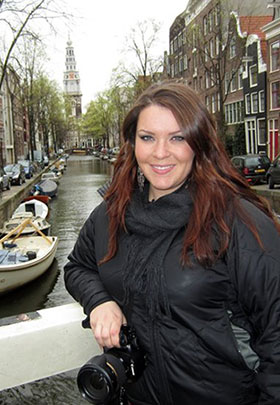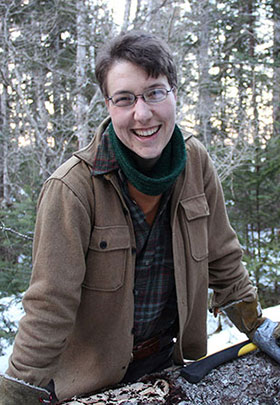Life on the Move
Nomads break from mainstream society to discover alternatives to the American Dream.
By Madeline Lumley
Amber Chapman didn’t have a plan.

Amber Chapman always wanted the nomad life.
“I just booked that one-way ticket and then I didn’t know what the f—k I was gonna do, but I really wanted to challenge myself and do things differently.”
The 29-year-old Seattle native made a life-changing decision out of the blue, much to the surprise of her friends and family. She turned to her boyfriend in October 2010 and said, “If I didn’t have this great house and you and stuff, I would sell everything I own and just go travel.”
His response: “Shit, you’re totally going to do that.”
Chapman had a bout of insatiable wanderlust since she was a kid. She wanted to be a nomad.
Turning Dreams into Reality
Chapman didn’t start her journey right away. Every decision after that conversation was made with the intent of traveling the world.
“I didn’t buy any new clothes, didn’t go shopping, nothing, for an entire year. I picked up extra jobs on the side; that type of thing,” Chapman said. “I was really fed up with my job, so I quit and started selling everything. Almost to the exact day of my decision the next year, I had already purchased my first ticket, which was a one-way to Amsterdam with a seven-day layover in Reykjavik, Iceland.”
Chapman didn’t know where she’d go after Amsterdam. She just wanted to keep moving. With about $17,000 saved up, she embarked on what became an exploration of more than 20 cities throughout Europe and Asia.
The nomadic lifestyle — moving from place to place, never considering one spot truly home — is one that has been romanticized and criticized in American culture. Those who choose such a lifestyle are after a different version of the American Dream; one that doesn’t include a 9-to-5 office job, a house in the suburbs or a luxury sedan. But that doesn’t mean modern nomads are all the same. In fact, the opposite is true, as is depicted in the BBC documentary “American Nomads,” written and produced by Richard Grant.
“People with bad upbringings sometimes become wanderers, and so do people from good upbringings. Loners wander and so do couples. Weak people take to the road and so do the strong,” Grant said at the end of the film. “But ultimately, people wander in America because they can — the space and possibility exists.”
Some, like Chapman, travel from one urban setting to the next. Others, like 31-year-old Mary Murphy, take routes that bring them closer to nature. Despite such key differences, they seem to have at least one major trait in common. Grant said a modern nomad is “someone who doesn’t feel stable when stationary. A nomad feels stable when experiencing velocity.”
Hitting the Reset Button
Murphy lives in the woods of Worcester, Vt., in a 72-square-foot home she built. She spends her days teaching wilderness skills and leading hikes across the natural landscape of northern New England. But she wasn’t always settled like this. Before starting her business, Mountainsong Expeditions, Murphy spent nearly eight years traveling around the United States.

Mary Murphy brings her nomad life close to nature.
Murphy moved from coast to coast and a few places in between. She’d switch from one wilderness job to another. “I’d fly somewhere, and they’d swoop me off into back country. I’d be out there for like six months, and then go back and get on a plane somewhere else,” Murphy said. She held seasonal jobs — from being a wilderness therapy guide for troubled teens in California to working at the International Wolf Center in Minnesota, educating herself and others about the wolves in the area.
On a whim, Murphy decided to spend six months living in an apartment in San Francisco (“Trying out the city,” as she put it). During those months, it became increasingly clear she was meant to live closer to nature. It was this realization that led to one of the biggest adventures of Murphy’s life: hiking the Appalachian Trail. Alone.
“I went into it really wanting to hit the reset button. I felt like I’d gotten a little bit off-track,” Murphy said. “Being in a city had been deadening to the joy in my life.”
Murphy began her journey in Georgia. She traveled more than 2,000 miles to Maine. Most travelers complete the hike in about six months. Murphy made it in three-and-a-half.
“When I got on the trail by myself, I felt so free. I could do exactly what I wanted, on my own schedule. I could make it as far and as fast as I felt like it,” Murphy said. “I could challenge myself as much as I wanted to, and nothing could hold me back.”
Her hike was therapeutic, but Murphy learned being alone on the trail isn’t always safe — especially as a woman. After a particularly strenuous day (43.2 miles in 21 hours straight, to be exact), Murphy fell asleep on a park bench, completely alone. This wasn’t a common occurrence; she spent most of her nights in shared shelters with other hikers. She slept peacefully until approaching locals woke her up.
“I was discovered by two really drunk men in the middle of the night. It all worked out, but I had a really strong fear that I was going to get raped or beaten or something, just hearing these really drunk, high men come up and see me,” Murphy said. She fended them off by letting them drunkenly believe her large backpack was actually her sleeping boyfriend (it was dark).
“Being alone, as a woman, you have a heightened sense of ‘stranger danger.’ Your instincts get incredibly sharp,” Murphy said. “I imagine that’s true for a lot of people when they’re living a nomadic lifestyle because you don’t have the community fabric of people you know and understand and trust. You’re constantly meeting new people and having to decide whether or not you trust them.”
Luckily — for Murphy and Chapman, alike — most of the people they met were positive influences in their lives.
Chapman found fulfillment in meeting a variety of people and immersing herself in their cultures.
“Traveling teaches you everything about life if you really embrace it,” Chapman said. “You find things out about yourself that will surprise you.”
For Murphy, hiking the Appalachian Trail was the perfect chance to reconnect with nature and reflect on life. She said, “You get three to six months to just think: What are your priorities? What do you value? What direction do you want to head after this? What do you want the next adventure to be?”
Photos courtesy of Amber Chapman and Mary Murphy
Rewriting the American Dream
Millennials don’t need the same life as their parents.
The American Dream used to be simple — at least that’s what we’ve been told. Supposedly women fantasized of white picket fences and a husband to welcome home with a stiff drink and a meal on the table. They dreamed of fancy kitchenettes, book clubs, a clean home and 2.5 perfect little children. It was a story fit for fairy tales, high school history textbooks and entry-level sociology courses…


Tell us what you think